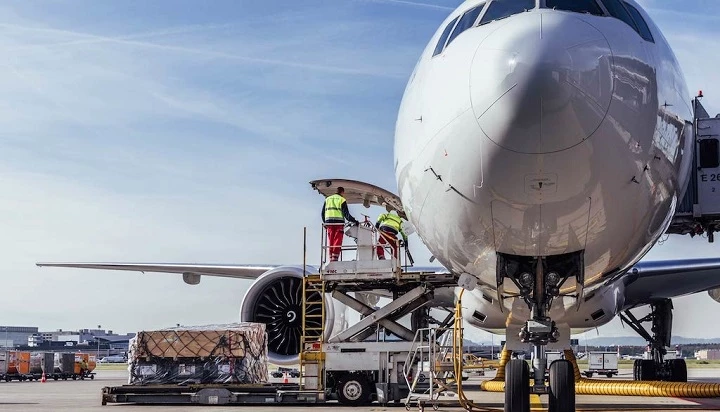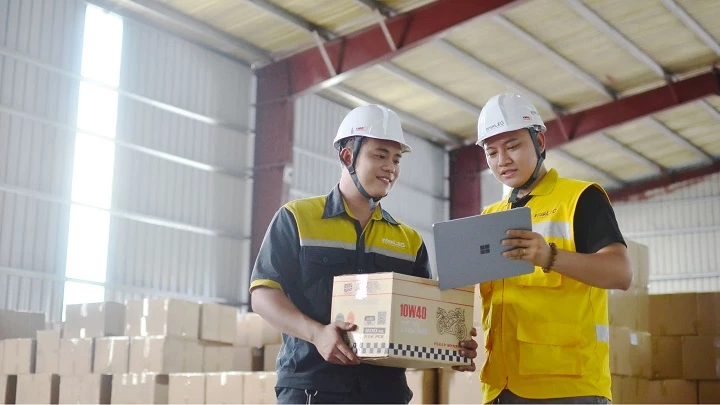Transporting goods by air is a transportation method that businesses are interested in today. Especially in the context of economic globalization, the transportation of goods is not only limited domestically but also imported and exported from Vietnam to international and vice versa. So what is air cargo transportation? Which items are suitable and what is the implementation process? Follow the article below to understand more about this method!
1. What is air freight service?
Transporting goods by air (Air Cargo) is a method of transporting goods by specialized aircraft (Cargo Aircraft, or Freighter), or carried in the belly compartment of passenger aircraft (Passenger Plane).
Although the weight of goods transported by air accounts for less than 1%, it accounts for about 35% of the value of world trade. This proves that the importance and profitability of air cargo can develop strongly in the coming time.
According to forecasts of incoming and outgoing goods traffic in East Asia, this continues to be the strongest growing market in the world; and Vietnam is considered a potential market with the fastest growing air cargo transport rate on the trans-Pacific route. Therefore, businesses should focus on promoting the transportation of goods by air to promote growth and increase opportunities for international economic integration.

With air cargo transport, goods are carefully packaged and placed on specialized aircraft or carried in the belly compartment of passenger aircraft.
2. Advantages and disadvantages when transporting goods by air
Air cargo transportation is a specific form of transportation, so it has the following advantages and disadvantages:
2.1. Advantage
Fast transport time: Airplanes are considered the fastest means of transport today. On average, the travel speed of a cargo or passenger plane is only about 800 - 1000km/h. Not to mention, air transportation by plane is not hindered by terrain so it can reach the recipient quickly.
Goods ensure high safety: International transport of goods by air can reduce the risk of goods being damaged due to collision. Besides, it also helps minimize losses arising from breakage, lost goods or theft.
Low insurance fees: From the strengths of cargo safety, it can be said that transporting goods by air is quite low risk. Therefore, the insurance fee will be lower than shipping by other methods.
Save storage costs: Goods transported by air are often small in volume, compact and need to be transported quickly, so they do not take up too much space and storage time. This helps businesses save maximum storage costs.
2.2. Defect
High transportation costs: Air transportation time is faster than sea or road transportation, and the process needs to ensure maximum rigor and safety. Therefore, the cost of transporting goods by air is quite high.
Limited transport volume: In order to ensure safe and convenient transport of packages, the size of air cargo will be limited, if it exceeds the allowable load of the aircraft.
Complicated procedures: To maintain flight security and safety, this form of air transport often has many complex regulations and procedures. Therefore, it is best for businesses to find companies that specialize in providing air freight services to get the fastest procedural support.
Affected by weather: In some cases, bad weather conditions such as fog, thunderstorms,... can cause the plane to be delayed or canceled. At this time, the goods may be stored and the recipient must wait for a certain period of time.

Yếu tố thời tiết có thể làm ảnh hưởng đến thời gian vận chuyển hàng hóa qua đường hàng không.
3. Types of goods allowed and not allowed to be transported by air
To use optimal air transport services, you need to know which items are and are not allowed to be transported. Specifically:
3.1. Types of goods allowed to be transported by air
Below are the types of goods commonly transported by air:
General Cargo: These are items that have no problems with size, content, packaging, etc. However, to ensure safety before being loaded into the shipping compartment, These types of goods also need to go through a strict inspection process to determine whether the size and volume are suitable or not.
Special Cargo: Includes goods such as live animals, high-value goods, remains, perishable goods, odorous goods, wet goods, diplomatic goods, cargo dangerous, large volume goods. The transportation of these items has its own characteristics, requiring service providers to have special handling techniques from storage to transportation.
3.2. Goods are not allowed to be transported by air
Some types of goods prohibited from being transported by air include:
Narcotics, psychoactive substances, bullet weapons, military technical equipment, rudimentary weapons such as knives, swords, spears, spears,...
Depraved cultural products, reactionary publications and documents aimed at destroying public order against the Vietnamese state.
Objects or substances that are flammable, explosive or unsanitary, causing environmental pollution.
Living organisms, foods requiring preservation, articles, publications, and goods prohibited from entering the country.
Precious metals, precious stones (gold, silver, platinum, etc.), or products made from precious metals and gems.
4. Details of the process of transporting goods by air
In order to easily monitor work progress, you need to understand how the necessary steps in the air transport process will take place. As follows:
4.1. Sign shipping contract
The shipping unit and the company using the service will sign a contract, after both parties have agreed to the regulations and terms on the method of transporting goods by air.
4.2. Booking
When receiving the Booking form from the shipping unit (Forwarder), the company needs to check the information such as: Departure airport, arrival airport, departure time, type of goods, quantity,... to prepare. goods delivered to the carrier.
4.3. Close the goods
Goods transported by air need to be carefully packaged, properly specified and labeled with the package code (as required by the importer). Then the company will transport the goods, or the Forwarder will take the goods to the airport warehouse. Here, after confirming the information of the shipment to be transported, the company will receive a certificate of receipt (FTC - Forwarder's Certificate of Transport).

Hàng hóa vận chuyển bằng đường hàng không cần được đóng gói cẩn thận, đảm bảo không bị móp méo.
4.4. Carry out export customs procedures
To transport goods to airlines and complete export customs procedures, shipments must be prepared with a full set of documents when being transported to the airport.
4.5. Issuing air waybills (AWB)
After completing export customs procedures, the airline will issue the MAWB - Master Air Waybill (master bill of lading issued by the airline) by the airline. In particular, 01 copy of AWB - Air Waybill (air waybill) is sent with the shipment to the destination airport, the remaining documents are kept by the Forwarder to serve in necessary cases.
Note: There is no regulation requiring exporters to submit separate sets of documents. Exporters can absolutely use the set of documents accompanying the original AWB to send to the importer.
4.6. Receive documents in advance via email
This step is performed after the shipment with documents has been transported. The forwarder will send a scanned copy of the original AWB No. 3 they receive, along with scanned copies of all other documents, to the importer via email.
4.7. Arrival notification
Before the plane lands at the destination airport, the expected delivery time and freight status will be notified to the importer by the carrier's agent. To avoid arising risks, the receiving party needs to check some necessary information such as: Date of arrival, place of storage, fees payable,...
4.8. Delivery order
At the time the goods arrive, the Forwarder will collect the original HAWB - House Air Waybill (house bill of lading issued by the forwarder) No. 2. Then go to the airline or their agent to pay the prescribed fees. such as: Delivery order fee (D/O), Handling fee, Labor fee, etc. Finally, the Forwarder receives the delivery order (D/O) along with a set of documents attached to the shipment. .
4.9. Carry out import customs procedures
Importers can complete customs procedures for importing goods themselves. However, if you use the services of an air transport company, when the goods arrive, the Forwarder will help the business complete this work.
4.10. Receive
The Forwarder company will be responsible for completing procedures at the airline's warehouse to pick up the goods, at the same time liquidate the declaration and transport the goods to the importer. Importing businesses only need to receive goods on time and check the condition of the goods to ensure there is no damage or loss.

Khi hàng về đến kho lưu trữ của sân bay đích, công ty Forwarder sẽ thực hiện các thủ tục nhận hàng và vận chuyển đến cho bên nhập khẩu.
5. Common terms in air cargo transportation
In the process of learning about air freight services, businesses also need to understand some commonly used terms to help the implementation process go more smoothly:
A2A – Airport-to-Airport: Transportation from departure airport to destination airport.
ATA – Actual Time of Arrival: Actual arrival time.
ATD – Actual Time of Departure: Actual departure time.
AWB - Air Waybill: Air waybill, divided into MAWB - Master Air Waybill (master bill of lading issued by the airline); and HAWB – House Air Waybill (house bill of lading issued by the forwarder).
Booking: It is recommended to book a seat on the plane and have it confirmed by the airline.
Dimensional Weight: Volumetric weight, is the space or volume of the shipment.
FTC - Forwarder's Certificate of Transport: Forwarder's certificate of transport.
FCR - Forwarder's Certificate of Receipt: Certificate of receipt of goods from the forwarder.
FWR – Forwarder’s Warehouse Receipt: Warehouse receipt of the forwarder (issued to the exporter).
GSA – General Sales Agent: Cargo handling agent designated by the airline.
IATA – International Air Transport Association: International Air Transport Association.
NOTOC – Notification To Captain: Notify the captain of the list of goods on the plane.
POD – Proof Of Delivery: Proof of delivery, documents showing that the carrier has delivered the goods as agreed.
TACT – The Air Cargo Tariff: Air freight tariff, published by the airline.
Volume charge: Airline charges are calculated based on cargo capacity (instead of weight).
Weight charge: Air freight charge, calculated based on the actual weight of the goods.
6. Prestigious and professional air freight service at InterLOG
With more than 20 years of experience at home and abroad, InterLOG is confident that it is a company that provides effective and optimal international transportation services (including air transportation) for many businesses.
In order to support businesses to easily access international markets and connect with customers globally, InterLOG has entered into a joint venture with ASEAN CARGO GATEWAY Joint Stock Company (ACG). Thanks to that, InterLOG has the privilege of operating separate cargo flights to serve Vietnamese agricultural products to strategic countries.
Not only that, InterLOG also has the opportunity to accompany many leading airlines such as Japan Airlines, Hong Kong Airlines, Singapore Airlines, China Airlines,... to maximally support the needs of domestic and foreign import-export businesses. In addition, InterLOG also contributes to simplifying the entire Logistics process of businesses, by providing seamless and reliable express delivery services, transportation and door-to-door delivery services.





 VN
VN EN
EN
